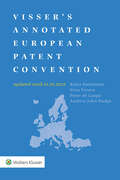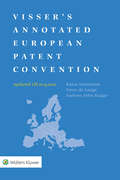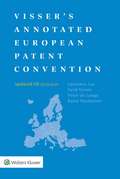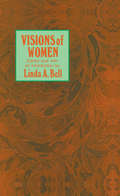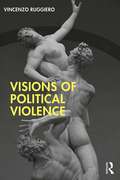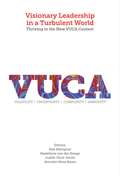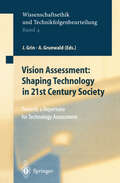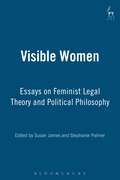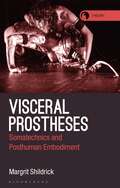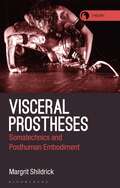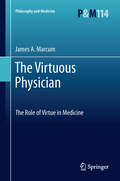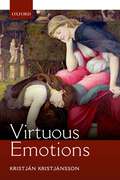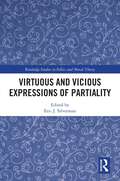- Table View
- List View
Visser's Annotated European Patent Convention 2023 Edition
by Peter De Lange Andrew Rudge Nina Ferara<span style="font-size:12.0pt;font-family:"firaSansBook",serif;mso-fareast-font-family: "Times New Roman";mso-bidi-font-family:"Times New Roman";color:#474747; mso-fareast-language:EN-GB">The book,<span style="font-size:12.0pt;font-family:"firaSansBook",serif;mso-fareast-font-family: "Times New Roman";mso-bidi-font-family:"Times New Roman";color:#474747; mso-fareast-language:EN-GB"> Visser’s Annotated European Patent Convention<span style="font-size:12.0pt;font-family:"firaSansBook",serif;mso-fareast-font-family: "Times New Roman";mso-bidi-font-family:"Times New Roman";color:#474747; mso-fareast-language:EN-GB">, is a commentary on the European Patent Convention and a bestseller in European patent law. <span style="font-size:12.0pt;font-family:"firaSansBook",serif;mso-fareast-font-family: "Times New Roman";mso-bidi-font-family:"Times New Roman";color:#474747; mso-fareast-language:EN-GB">The 2023 edition of this preeminent work – the only regularly updated authoritative article-by-article commentary in English on the European Patent Convention (EPC), its implementing regulations, and associated case law provides the complete text of the law annotated with commentary and expert guidance on the interpretation of each paragraph. Since its first edition in 1994 it has provided the European patent community with the necessary insights to practice successfully before the European Patent Office. The EPO recommends the <span style="font-size:12.0pt;font-family:"firaSansBook",serif;mso-fareast-font-family: "Times New Roman";mso-bidi-font-family:"Times New Roman";color:#474747; mso-fareast-language:EN-GB">Visser’s Annotated European Patent Convention<span style="font-size:12.0pt;font-family:"firaSansBook",serif;mso-fareast-font-family: "Times New Roman";mso-bidi-font-family:"Times New Roman";color:#474747; mso-fareast-language:EN-GB"> as the first book in its list of non-EPO/WIPO literature to be used for the preparation of the European qualifying examination. <span style="font-size:12.0pt;font-family:"firaSansBook",serif;mso-fareast-font-family: "Times New Roman";mso-bidi-font-family:"Times New Roman";color:#474747; mso-fareast-language:EN-GB">In addition to a thorough updating of developments, new material in the 2023 edition includes the following: <li style="color:#474747;mso-margin-top-alt:auto;mso-margin-bottom-alt: auto;line-height:normal;mso-list:l0 level1 lfo1;tab-stops:list 36.0pt; background:white" class="MsoNormal"><span style="font-size:12.0pt;font-family: "firaSansBook",serif;mso-fareast-font-family:"Times New Roman";mso-bidi-font-family: "Times New Roman";mso-fareast-language:EN-GB">Amended EPO Guidelines that entered into force on 01.03.2023 <li style="color:#474747;mso-margin-top-alt:auto;mso-margin-bottom-alt: auto;line-height:normal;mso-list:l0 level1 lfo1;tab-stops:list 36.0pt; background:white" class="MsoNormal"><span style="font-size:12.0pt;font-family: "firaSansBook",serif;mso-fareast-font-family:"Times New Roman";mso-bidi-font-family: "Times New Roman";mso-fareast-language:EN-GB">Commentary on recent amendments to the Implementing Regulations <li style="color:#474747;mso-margin-top-alt:auto;mso-margin-bottom-alt: auto;line-height:normal;mso-list:l0 level1 lfo1;tab-stops:list 36.0pt; background:white" class="MsoNormal"><span style="font-size:12.0pt;font-family: "firaSansBook",serif;mso-fareast-font-family:"Times New Roman";mso-bidi-font-family: "Times New Roman";mso-fareast-language:EN-GB">Recent decisions of the boards of appeal <li style="color:#474747;mso-margin-top-alt:auto;mso-margin-bottom-alt: auto;line-height:normal;mso-list:l0 level1 lfo1;tab-stops:list 36.0pt; background:white" class="MsoNormal"
Visser's Annotated European Patent Convention 2022 Edition
by Peter De Lange Andrew Rudge<span style="font-size:12.0pt;font-family:"firaSansBook",serif;mso-fareast-font-family: "Times New Roman";mso-bidi-font-family:"Times New Roman";color:#474747; mso-fareast-language:EN-GB"> The book,<span style="font-size:12.0pt;font-family:"firaSansBook",serif;mso-fareast-font-family: "Times New Roman";mso-bidi-font-family:"Times New Roman";color:#474747; mso-fareast-language:EN-GB"> Visser’s Annotated European Patent Convention<span style="font-size:12.0pt;font-family:"firaSansBook",serif;mso-fareast-font-family: "Times New Roman";mso-bidi-font-family:"Times New Roman";color:#474747; mso-fareast-language:EN-GB">, is a commentary on the European Patent Convention and a bestseller in European patent law. <span style="font-size:12.0pt;font-family:"firaSansBook",serif;mso-fareast-font-family: "Times New Roman";mso-bidi-font-family:"Times New Roman";color:#474747; mso-fareast-language:EN-GB"> The 2022 edition of this preeminent work – the only regularly updated authoritative article-by-article commentary in English on the European Patent Convention (EPC), its implementing regulations, and associated case law provides the complete text of the law annotated with commentary and expert guidance on the interpretation of each paragraph. Since its first edition in 1994 it has provided the European patent community with the necessary insights to practice successfully before the European Patent Office. The EPO recommends the <span style="font-size:12.0pt;font-family:"firaSansBook",serif;mso-fareast-font-family: "Times New Roman";mso-bidi-font-family:"Times New Roman";color:#474747; mso-fareast-language:EN-GB">Visser’s Annotated European Patent Convention<span style="font-size:12.0pt;font-family:"firaSansBook",serif;mso-fareast-font-family: "Times New Roman";mso-bidi-font-family:"Times New Roman";color:#474747; mso-fareast-language:EN-GB"> as the first book in its list of non-EPO/WIPO literature to be used for the preparation of the European qualifying examination. <span style="font-size:12.0pt;font-family:"firaSansBook",serif;mso-fareast-font-family: "Times New Roman";mso-bidi-font-family:"Times New Roman";color:#474747; mso-fareast-language:EN-GB"> In addition to a thorough updating of developments, new material in the 2022 edition includes the following: <li style="color:#474747;mso-margin-top-alt:auto;mso-margin-bottom-alt: auto;line-height:normal;mso-list:l0 level1 lfo1;tab-stops:list 36.0pt; background:white" class="MsoNormal"><span style="font-size:12.0pt;font-family: "firaSansBook",serif;mso-fareast-font-family:"Times New Roman";mso-bidi-font-family: "Times New Roman";mso-fareast-language:EN-GB">Amended EPO Guidelines that entered into force on 01.03.2022 <li style="color:#474747;mso-margin-top-alt:auto;mso-margin-bottom-alt: auto;line-height:normal;mso-list:l0 level1 lfo1;tab-stops:list 36.0pt; background:white" class="MsoNormal"><span style="font-size:12.0pt;font-family: "firaSansBook",serif;mso-fareast-font-family:"Times New Roman";mso-bidi-font-family: "Times New Roman";mso-fareast-language:EN-GB">Consolidated discussion of procedures relating to oral proceedings held by videoconference <li style="color:#474747;mso-margin-top-alt:auto;mso-margin-bottom-alt: auto;line-height:normal;mso-list:l0 level1 lfo1;tab-stops:list 36.0pt; background:white" class="MsoNormal"><span style="font-size:12.0pt;font-family: "firaSansBook",serif;mso-fareast-font-family:"Times New Roman";mso-bidi-font-family: "Times New Roman";mso-fareast-language:EN-GB">Commentary on recent amendments to the Implementing Regulations <li style="color:#474747;mso-margin-top-alt:auto;mso-margin-bottom-alt: auto;line-height:normal;mso-list:l0 level1 lfo1;tab-stops:
Visser's Annotated European Patent Convention 2021 Edition
by Laurence Lai Derk VisserThe book, Visser’s Annotated European Patent Convention, is a commentary on the European Patent Convention and a bestseller in European patent law. The 2021 edition of this preeminent work – the only regularly updated authoritative article-by-article commentary in English on the European Patent Convention (EPC), its implementing regulations, and associated case law provides the complete text of the law annotated with commentary and expert guidance on the interpretation of each paragraph. Since its first edition in 1994 it has provided the European patent community with the necessary insights to practice successfully before the European Patent Office. The EPO recommends the Visser’s Annotated European Patent Convention as the first book in its list of non-EPO/WIPO literature to be used for the preparation of the European qualifying examination. In addition to a thorough updating of developments, new material in the 2021 edition includes the following: Amended EPO Guidelines that entered into force on 01.03.2021 Consolidated discussion of procedures relating to oral proceedings held by video conference Commentary on recent amendments to the implementing regulations Recent decisions of the boards of appeal The 2021 edition is suitable for candidates preparing for the EQE 2022. A free supplemental note will be published providing candidates with an overview of the main legal changes between the 2021 edition and the 31.10.2021 legal cut-off date for the EQE 2022.
Visser's Annotated European Patent Convention 2019 Edition
by Derk VisserThe book Visser’s Annotated European Patent Convention is a commentary on the European Patent Convention and a bestseller in European patent law. Each year a new, updated edition of the book is published and available in paperback form. The 2019 edition of this preeminent work – the only regularly updated authoritative article-by-article commentary in English on the European Patent Convention (EPC), its implementing regulations, and associated case law – provides the complete text of the 2000 Convention annotated with commentary and expert guidance on the interpretation of each paragraph. Since its first edition in 1994 it has provided the European patent community with the necessary insights to practice successfully before the European Patent Office. The EPO recommends the Visser’s Annotated European Patent Convention as the first book in its list of non-EPO/WIPO literature to be used for the preparation of the European qualifying examination. In addition to a thorough updating of developments, new material in this edition includes the following: New Rules of Procedure of the Boards of Appeal; New EPO Guidelines that enter into force on 01.11.2019; The references to Guidelines 2018 are kept for the eqe 2020 candidates.
Visions of Women: Being a Fascinating Anthology with Analysis of Philosophers’ Views of Women from Ancient to Modern Times (Contemporary Issues in Biomedicine, Ethics, and Society)
by Linda A. BellPeople of Socrates' time were frequently aghast at the questions he would ask. Their responses were of the sort elicited by very dumb or ex tremely obvious questions: "Don't you know? Everyone else does. " Socrates was hardly alone in his knack for asking such questions. Phi losophers have always asked peculiar questions most other people would never dream of asking, convinced as the latter are that the answers were settled long ago in the collective "wisdom" of society, including ques tions about woman: should women be educated? should they rule socie ties? should they be subordinate in marriage? do women and men have the same virtues, or are there separate virtues for each? which of the dif ferences between women and men are conventional, and which are natu ral? is there a woman's work? do women and men have different types or degrees of rationality? Philosophers of the most diverse periods have raised these questions and their answers were often quite creative, not merely reflecting the conventions and mores of their societies. With the publication of this anthology, their writings will be brought together in a single volume for the first time. This anthology differs from others not just in its inclusiveness. It also contains several translations of material previously unavailable in English.
Visions of Political Violence
by Vincenzo RuggieroIn this book, Vincenzo Ruggiero offers a typology of different forms of political violence. From systemic and institutional violence, to the behaviour of crowds, to armed conflict and terrorism, Ruggiero draws on a range of perspectives from criminology, social theory, political science, critical legal studies and literary criticism to consider how these forms of violence are linked in an interdependent field of forces. Ruggiero argues that systemic violence encourages more institutional violence, which in turn weakens the ability of citizens to set up political agendas for change. He advocates for a reduction of all types of violence, which can be enacted through fairer distribution of resources and the provision of political space for contention and negotiation. This book will be of interest to all those engaged in research on violence, terrorism, armed conflict and the crimes of the powerful. It makes an important contribution to criminological and social theory.
Visions of Political Violence
by Vincenzo RuggieroIn this book, Vincenzo Ruggiero offers a typology of different forms of political violence. From systemic and institutional violence, to the behaviour of crowds, to armed conflict and terrorism, Ruggiero draws on a range of perspectives from criminology, social theory, political science, critical legal studies and literary criticism to consider how these forms of violence are linked in an interdependent field of forces. Ruggiero argues that systemic violence encourages more institutional violence, which in turn weakens the ability of citizens to set up political agendas for change. He advocates for a reduction of all types of violence, which can be enacted through fairer distribution of resources and the provision of political space for contention and negotiation. This book will be of interest to all those engaged in research on violence, terrorism, armed conflict and the crimes of the powerful. It makes an important contribution to criminological and social theory.
Visions of Cannabis Control
by Jon Heidt Johannes WheeldonVisions of Cannabis Control argues that cannabis prohibition is the result of moral panic that has been instigated, perpetuated, and sustained in ways that are difficult to dislodge. The book documents the history of these cannabis policies and explores the impact of issues such as racism, labelling, and stigmatization. Stan Cohen argued that reforms designed to replace carceral tendencies within correctional institutions can instead extend such approaches into our communities. The idea that criminal justice reforms often reproduce what they were intended to disrupt can be applied to the cannabis revolution currently underway around the world. Racial disparities in arrests persist, exacerbated by laws that make it legal to possess cannabis but illegal to consume it anywhere but in your home. In this book, the authors argue that too often, cannabis liberalization comes at the cost of expanding paternalistic public health models and abstention-based diversion programs. The goal of dismantling and disrupting illicit markets has undermined onerous regulations, anaemic marketing efforts, and failure to promote consumer-centred approaches. Emphasizing public health goals ahead of market conditions complicates legal cannabis as an industry. To understand the future of cannabis policy, Visions of Cannabis Control examines the experience of six countries and several US states through the lens of criminological theory, recent research, and practice. The book presents several solutions for responsible regulation concluding that sustaining reform will require a more inclusive approach ensuring those affected by cannabis policies are consulted, respected, and involved.
Visions of Cannabis Control
by Jon Heidt Johannes WheeldonVisions of Cannabis Control argues that cannabis prohibition is the result of moral panic that has been instigated, perpetuated, and sustained in ways that are difficult to dislodge. The book documents the history of these cannabis policies and explores the impact of issues such as racism, labelling, and stigmatization. Stan Cohen argued that reforms designed to replace carceral tendencies within correctional institutions can instead extend such approaches into our communities. The idea that criminal justice reforms often reproduce what they were intended to disrupt can be applied to the cannabis revolution currently underway around the world. Racial disparities in arrests persist, exacerbated by laws that make it legal to possess cannabis but illegal to consume it anywhere but in your home. In this book, the authors argue that too often, cannabis liberalization comes at the cost of expanding paternalistic public health models and abstention-based diversion programs. The goal of dismantling and disrupting illicit markets has undermined onerous regulations, anaemic marketing efforts, and failure to promote consumer-centred approaches. Emphasizing public health goals ahead of market conditions complicates legal cannabis as an industry. To understand the future of cannabis policy, Visions of Cannabis Control examines the experience of six countries and several US states through the lens of criminological theory, recent research, and practice. The book presents several solutions for responsible regulation concluding that sustaining reform will require a more inclusive approach ensuring those affected by cannabis policies are consulted, respected, and involved.
Visionary Leadership in a Turbulent World: Thriving in the New VUCA Context
by Rob Elkington Madeleine van der Steege Judith Glick-Smith Jennifer Moss BreenVisionary Leadership in a Turbulent World: Thriving in the New VUCA Context, is the thoughtful analysis of nine expert authors from around the globe who put VUCA under the microscope and take the reader on a journey that looks at VUCA from a number of different leadership perspectives. Through their research and writing these nine authors seek to provide sense-making and insights that are combined with practical tips and frameworks to help leadership embrace this new VUCA context and learn how to thrive within it. The book suggests ways in which organizational leadership can seek to develop both the self and the organization to systemically and ethically address VUCA with innovation, collaboration, and cultural intelligence, whilst also effectively managing the self with resilience and flow, and supporting everyone in the organization with effective systems coaching. Visionary Leadership in a Turbulent World: Thriving in the New VUCA Context, by the collaboration that engendered it, the innovation and research that supported it, and the teamwork that brought it to completion in the midst of real VUCA moments, models the principles and practices outlined in this excellent book.
Visionary Leadership in a Turbulent World: Thriving in the New VUCA Context
by Rob Elkington Madeleine van der Steege Judith Glick-Smith Jennifer Moss BreenVisionary Leadership in a Turbulent World: Thriving in the New VUCA Context, is the thoughtful analysis of nine expert authors from around the globe who put VUCA under the microscope and take the reader on a journey that looks at VUCA from a number of different leadership perspectives. Through their research and writing these nine authors seek to provide sense-making and insights that are combined with practical tips and frameworks to help leadership embrace this new VUCA context and learn how to thrive within it. The book suggests ways in which organizational leadership can seek to develop both the self and the organization to systemically and ethically address VUCA with innovation, collaboration, and cultural intelligence, whilst also effectively managing the self with resilience and flow, and supporting everyone in the organization with effective systems coaching. Visionary Leadership in a Turbulent World: Thriving in the New VUCA Context, by the collaboration that engendered it, the innovation and research that supported it, and the teamwork that brought it to completion in the midst of real VUCA moments, models the principles and practices outlined in this excellent book.
Vision Assessment: Towards a Repertoire for Technology Assessment (Ethics of Science and Technology Assessment #4)
by D.M.A. UhlOne way to shape technology and its embedding in society in the 21st century is through the visions that guide their development, especially concerning the long-term societal perspective. A critical discussion and assessment of these visions is a prerequisite for influencing the course of development. Technology assessment, therefore, has to provide a methodological repertoire for assessing and constructing visions, taking into account the requirements for long-term orientation as well as the need for public legitimation. This volume draws upon insights from technology assessment, political sciences, epistemology, sociology and ethics. It is to contribute to the recent literature in on "shaping technology", taking into account the "co-evolution of technology and society". It connects to that technology assessment literature that emphasises TA's pro-active role and its contribution to political judgement.
Visible Women: Essays on Feminist Legal Theory and Political Philosophy
by Susan James Stephanie PalmerHow should feminist theories conceive of the subject? What is it to be a legal person? What part does embodiment play in subjectivity? Can there be a conception of rights which does justice to the social contexts in which rights claims are embedded? Is the way the law constitutes legal subjects a form of violence? These questions lie at the heart of contemporary feminist theory,and in this collection they are addressed by a group of distinguished international scholars working in law, philosophy and politics. The volume, in which the concerns of one author are taken up by others, advances current debate on two interconnected levels. First, it contains original and ground-breaking discussions of the questions raised above. At the same time, it contains a more reflexive strand of argument about the intellectual resources available to feminist thinkers, and the advantages and dangers of borrowing from non-feminist traditions of thought. It thus provides an exceptionally rich examination of contemporary legal and political feminist theory.
Visceral Prostheses: Somatechnics and Posthuman Embodiment (Theory in the New Humanities)
by Margrit ShildrickIn the postmodern era, when the interface of bodies, biologies and technologies increasingly challenges the very notion of what counts as human, Margrit Shildrick proposes new understandings of the limits and possible extensions of posthuman embodiment. Focusing on prostheses, Shildrick broadens our understanding of both what prostheses are and what they might mean for human embodiment. As well as rehabilitation devices used by disabled people to replace or augment impaired parts of the body, Shildrick introduces visceral organic prostheses, which involve any cellular material that cannot be identified with the self, from organ transplantation to the physiological processes of microchimerism and the microbiome. Beyond origin narratives that concentrate on 'host' and 'guest' and 'self' and 'other', she examines the transformative possibilities that prostheses offer as they extend the nature of the embodied self beyond genetic singularity. Building on cutting-edge interdisciplinary research in critical disability studies, transplantation studies, and bioscience, Visceral Prostheses argues that bodies with prostheses in whatever form should no longer be understood as irregular forms of normative embodiment, but as limit cases of a common experience. In doing so, it challenges the western understanding of the singular self and welcomes a new understanding of the human.
Visceral Prostheses: Somatechnics and Posthuman Embodiment (Theory in the New Humanities)
by Margrit ShildrickIn the postmodern era, when the interface of bodies, biologies and technologies increasingly challenges the very notion of what counts as human, Margrit Shildrick proposes new understandings of the limits and possible extensions of posthuman embodiment. Focusing on prostheses, Shildrick broadens our understanding of both what prostheses are and what they might mean for human embodiment. As well as rehabilitation devices used by disabled people to replace or augment impaired parts of the body, Shildrick introduces visceral organic prostheses, which involve any cellular material that cannot be identified with the self, from organ transplantation to the physiological processes of microchimerism and the microbiome. Beyond origin narratives that concentrate on 'host' and 'guest' and 'self' and 'other', she examines the transformative possibilities that prostheses offer as they extend the nature of the embodied self beyond genetic singularity. Building on cutting-edge interdisciplinary research in critical disability studies, transplantation studies, and bioscience, Visceral Prostheses argues that bodies with prostheses in whatever form should no longer be understood as irregular forms of normative embodiment, but as limit cases of a common experience. In doing so, it challenges the western understanding of the singular self and welcomes a new understanding of the human.
Visa Policy within the European Union Structure
by Annalisa MeloniThe book focuses on the common visa policy as a case study on the constitutional structure of the European Union. After introducing the nature of visas, the book concentrates on the difficulties in forging a common visa policy at European level. Cooperation on visas has been characterized by a continuous reformulation of the framework for cooperation. The book describes cooperation before the Treaty on European Union adopted at Maastricht, under the Maastricht Treaty, and under the Treaty of Amsterdam. Furthermore, the book traces the essential characteristics of the common visa policy.
Viruses and Nanotechnology (Current Topics in Microbiology and Immunology #327)
by Marianne Manchester Nicole F. SteinmetzNanotechnology is a collective term describing a broad range of relatively novel topics. Scale is the main unifying theme, with nanotechnology being concerned with matter on the nanometer scale. A quintessential tenet of nanotechnology is the precise self-assembly of nanometer-sized components into ordered devices. Nanotechnology seeks to mimic what nature has achieved, with precision at the nanometer level down to the atomic level. Nanobiotechnology, a division of nanotechnology, involves the exploitation of biomaterials, devices or methodologies in the nanoscale. In recent years a set of b- molecules has been studied and utilized. Virus particles are natural nanomaterials and have recently received attention for their tremendous potential in this field. The extensive study of viruses as pathogens has yielded detailed knowledge about their biological, genetic, and physical properties. Bacterial viruses (bacte- ophages), plant and animal eukaryotic viruses, and viruses of archaea have all been characterized in this manner. The knowledge of their replicative cycles allows manipulation and tailoring of particles, relying on the principles of self-assembly in infected hosts to build the base materials. The atomic resolution of the virion structure reveals ways in which to tailor particles for higher-order functions and assemblies.
Virtuous Thoughts: The Philosophy of Ernest Sosa (Philosophical Studies Series)
by John TurriThis collection is a major contribution to the understanding and evaluation of Ernest Sosa’s profound and wide-ranging philosophy, in epistemology and beyond. A balanced, fair and critical volume, it offers a sensitive appreciation of his wide philosophical purview, a nuanced assessment of the detail of his thought, and a spur to exploring the linkages between the varied topics explored by the subtle mind of this great American scholar.The papers explore a wealth of Sosa’s academic interests, including his work on philosophical method, the philosophy of mind and language, metaphysics, and value theory, in addition to his output on epistemology itself. It offers, for example, a rebuttal of the counterarguments to Sosa’s reliabilist theory of introspective justification, which itself concludes with some objections to Sosa’s stated views on the ‘speckled hen’ problem. Other authors track the connections of his virtue theory to his advocacy of bi-level epistemology, provide reflections on Sosa’s views on the epistemological tradition, and examine the nexus of his beliefs on intuition and philosophical methodology. This volume is an insightful reckoning of Sosa’s academic account.
The Virtuous Psychiatrist: Character Ethics in Psychiatric Practice (International Perspectives in Philosophy and Psychiatry)
by Jennifer Radden John SadlerThe context for this interdisciplinary work by a philosopher and a clinician is the psychiatric care provided to those with severe mental disorders. Such a setting makes distinctive moral demands on the very character of the practitioner, it is shown, calling for special virtues and greater virtue than many other practice settings. In a practice so attentive to the patient's self identity, the authors promote a heightened awareness of cultural and particularly gender issues. By elucidating the nature of the moral psychology and character of the good psychiatrist, this work provides a sustained application of virtue theory to clinical practice. With its roots in Aristotelian writing, The Virtuous Psychiatrist presents virtue traits as habits, able to be cultivated and enhanced through training. The book describes these traits, and how they can be habituated in clinical training. A turn towards virtue theory within philosophy during the last several decades has resulted in important research on professional ethics. By approaching the ethics of psychiatric professionals in these virtue terms, Radden and Sadler's work provides an original application of this theorizing to practice. Of interest to both theorists and practitioners, the book explores the tension between the model of enduring character implicit in virtue theory and the segmented personae of role-specific moral responses. Clinical examples are provided, based upon dramaturgical vignettes (caseplays) which illustrate both the interactions of the case participants as well as the inner monologue of the clinician protagonist.
The Virtuous Physician: The Role of Virtue in Medicine (Philosophy and Medicine #114)
by James A. MarcumAlthough modern medicine enjoys unprecedented success in providing excellent technical care, many patients are dissatisfied with the poor quality of care or the unprofessional manner in which physicians sometimes deliver it. Recently, this patient dissatisfaction has led to quality-of-care and professionalism crises in medicine. In this book, the author proposes a notion of virtuous physician to address these crises. He discusses the nature of the two crises and efforts by the medical profession to resolve them and then he briefly introduces the notion of virtuous physician and outlines its basic features. Further, virtue theory is discussed, along with virtue ethics and virtue epistemology, and specific virtues, especially as they relate to medicine. The author also explores the ontological priority of caring as the metaphysical virtue for grounding the notion of virtuous physician, and two essential ontic virtues—care and competence. In addition to this, he examines the transformation of competence into prudent wisdom and care into personal radical love to forge the compound virtue of prudent love, which is sufficient for defining the virtuous physician. Lastly, two clinical case stories are reconstructed which illustrate the various virtues associated with medical practice, and it is discussed how the notion of virtuous physician addresses the quality-of-care and professionalism crises.
Virtuous Emotions
by Kristján KristjánssonMany people are drawn towards virtue ethics because of the central place it gives to emotions in the good life. Yet it may seem odd to evaluate emotions as virtuous or non-virtuous, for how can we be held responsible for those powerful feelings that simply engulf us? And how can education help us to manage our emotional lives? The aim of this book is to offer readers a new Aristotelian analysis and moral justification of a number of emotions that Aristotle did not mention (awe, grief, and jealousy), or relegated, at best, to the level of the semi-virtuous (shame), or made disparaging remarks about (gratitude), or rejected explicitly (pity, understood as pain at another person's deserved bad fortune). Kristján Kristjánsson argues that there are good Aristotelian reasons for understanding those emotions either as virtuous or as indirectly conducive to virtue. Virtuous Emotions begins with an overview of Aristotle's ideas on the nature of emotions and of emotional value, and concludes with an account of Aristotelian emotion education.
Virtuous Emotions
by Kristján KristjánssonMany people are drawn towards virtue ethics because of the central place it gives to emotions in the good life. Yet it may seem odd to evaluate emotions as virtuous or non-virtuous, for how can we be held responsible for those powerful feelings that simply engulf us? And how can education help us to manage our emotional lives? The aim of this book is to offer readers a new Aristotelian analysis and moral justification of a number of emotions that Aristotle did not mention (awe, grief, and jealousy), or relegated, at best, to the level of the semi-virtuous (shame), or made disparaging remarks about (gratitude), or rejected explicitly (pity, understood as pain at another person's deserved bad fortune). Kristján Kristjánsson argues that there are good Aristotelian reasons for understanding those emotions either as virtuous or as indirectly conducive to virtue. Virtuous Emotions begins with an overview of Aristotle's ideas on the nature of emotions and of emotional value, and concludes with an account of Aristotelian emotion education.
Virtuous Cycles in Humanistic Management: From the Classroom to the Corporation (Contributions to Management Science)
by Ricardo Aguado Almudena EizaguirreThis volume is divided into three major parts, each of which symbolizes a new virtuous circle that is added to the previous one in order to foster the dissemination of humanistic management (HM) among corporations and social institutions. After an introductory chapter explaining the concept of humanistic management and the plan behind this research project, the first part of the book is devoted to education. The authors address pedagogical strategies that can be used in higher education to introduce students to HM.In turn, the second part of the book focuses on the implementation of HM in corporations, while the third presents an approach for measuring and monetizing the social value generated by corporations through their economic activities. In the closing chapter, the editors illustrate how the three parts of the book can be combined to generate virtuous cycles in corporations.
Virtuous and Vicious Expressions of Partiality (Routledge Studies in Ethics and Moral Theory)
by Eric J. SilvermanThis volume gathers essays from leading scholars to discuss partiality in ethics. The chapters examine the virtuous and vicious ways in which we relate to those close to us. There has long been a puzzle in ethics concerning the balance between our general moral obligations to everyone and our specific moral obligations to a smaller subset of people: our family, our nation, and our friends. There has been longstanding tension between the moral intuition that equality entails that we have the same moral duties to everyone and the moral intuition that special obligations entail that we have much greater duties to those close to us. The chapters in this volume discuss varying perspectives on partiality within a wide range of relationships. Section 1 offers overarching visions of partiality. Section 2 examines how roles and relationships might shape partiality. Section 3 focuses on the potential moral dangers and pitfalls of partiality. Finally, Section 4 looks at specific applications of partiality expressed as our loyalty to country, religion, sports teams, and employers. Virtuous and Vicious Expressions of Partiality will be of interest to scholars and advanced students working in ethics, social and political philosophy, and philosophy of religion.
Virtuous and Vicious Expressions of Partiality (Routledge Studies in Ethics and Moral Theory)
This volume gathers essays from leading scholars to discuss partiality in ethics. The chapters examine the virtuous and vicious ways in which we relate to those close to us. There has long been a puzzle in ethics concerning the balance between our general moral obligations to everyone and our specific moral obligations to a smaller subset of people: our family, our nation, and our friends. There has been longstanding tension between the moral intuition that equality entails that we have the same moral duties to everyone and the moral intuition that special obligations entail that we have much greater duties to those close to us. The chapters in this volume discuss varying perspectives on partiality within a wide range of relationships. Section 1 offers overarching visions of partiality. Section 2 examines how roles and relationships might shape partiality. Section 3 focuses on the potential moral dangers and pitfalls of partiality. Finally, Section 4 looks at specific applications of partiality expressed as our loyalty to country, religion, sports teams, and employers. Virtuous and Vicious Expressions of Partiality will be of interest to scholars and advanced students working in ethics, social and political philosophy, and philosophy of religion.
